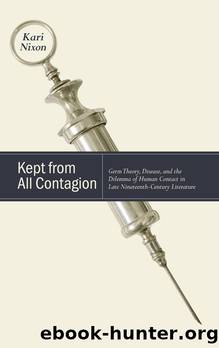Kept From All Contagion by Kari Nixon;

Author:Kari Nixon; [Nixon;, Kari]
Language: eng
Format: epub
ISBN: 9781438478500
Publisher: SUNY Press
Published: 2020-07-15T05:00:00+00:00
âA Terrible Tension in the Airâ: Female Bonds in The Story of a Modern Woman
A similarly overt awareness of a systemic evil that prevents women from recognizing their shared oppression pervades Ella Hepworth Dixonâs The Story of a Modern Woman. In Dixonâs novel, class is an ineffectual barrier to invisible microbes, which link the women in the novel through contagion, rendering their shared interests starkly visible. Much as Brontë, Braddon, and Wood deftly mold tubercular tropes to serve their messages about women, rather than simply mirroring scientific discourse, Dixon, while living just in the wake of germ theoryâs popular cultural hold, selects this rhetoric from a multiplicity of options in order to make her case. Dixonâs novel, published in 1894, came well after germ theory was widely accepted in the 1870s and â80s and nearly fifteen years after Robert Koch discovered the precise microbe that caused tuberculosis. However, as mentioned earlier, consumptionâs perplexing mode of transmission caused it to remain something of an etiological mystery, and while many late-century articles espoused the contagiousness of the disease, almost as many continued to insist upon an (often simultaneous) inherited, predisposed weakness to the microbe, an argument that often culminated in eugenicist discourse.98 As late as 1912, famed Victorian statistician Karl Pearson devoted an entire book, Tuberculosis, Heredity, and the Environment, to the topic. After a great deal of statistical analysis, he concludes the text by explaining that eugenicists like himself have âsomething better to proposeâ than mere etiological considerations.99 He continues:
No one can study the pedigrees of pathological states, insanity, mental defect, albinism &c., collected by our Laboratory, without being struck by the large proportion of tuberculous membersâoccasionally the tuberculous man is a brilliant member of our raceâbut the bulk of the tuberculous belongs to stocks which we want ab initio to discourage. Everything which tends to check the multiplication of the unfit, to emphasize the fertility of the physically and mentally healthy, will pro tanto aid Natureâs method of reducing the [tuberculosis] death rate. That is what the Eugenist proclaims as the âbetter thing to do,â and £1,500,000 spent in encouraging healthy [bloodlines] would do more than the establishment of a sanatorium in every township.100
Even into the twentieth century, then, the mythos of tuberculosis pervaded social discourse, hovering miasmatically and persistently in spite of the bacteriological rhetoric that was taking center stage in regard to most diseases. While no one could deny that tuberculosis was associated with a bacterium, its mysterious epidemiological pathway kept the notion of a hereditary weaknessâoften construed in this late period as an inherited susceptibility to the bacillusâalive. âThis impaired power of resistance,â one 1897 article proclaims, âmay be the result of heredity.â101 The author, like Pearson, concludes that it is âunfortunate that such matters are so little considered in marrying. ⦠It is not that the disease is inherited, but the vulnerable tissues, the feeble resistive powers, render the offspring an easy prey to the ubiquitous bacillus.â102 In spite of the continuing viability of the rhetoric
Download
This site does not store any files on its server. We only index and link to content provided by other sites. Please contact the content providers to delete copyright contents if any and email us, we'll remove relevant links or contents immediately.
The Art of Coaching by Elena Aguilar(50008)
Thinking, Fast and Slow by Kahneman Daniel(10576)
The Art of Thinking Clearly by Rolf Dobelli(8840)
The 5 Love Languages: The Secret to Love That Lasts by Gary Chapman(8492)
Mindhunter: Inside the FBI's Elite Serial Crime Unit by John E. Douglas & Mark Olshaker(7833)
Therapeutic Modalities for Musculoskeletal Injuries, 4E by Craig R. Denegar & Ethan Saliba & Susan Saliba(7348)
Periodization Training for Sports by Tudor Bompa(7327)
When Breath Becomes Air by Paul Kalanithi(7261)
Bodyweight Strength Training by Jay Cardiello(7184)
Becoming Supernatural by Dr. Joe Dispenza(7103)
Turbulence by E. J. Noyes(7037)
Nudge - Improving Decisions about Health, Wealth, and Happiness by Thaler Sunstein(6633)
The Road Less Traveled by M. Scott Peck(6633)
Enlightenment Now: The Case for Reason, Science, Humanism, and Progress by Steven Pinker(6405)
Win Bigly by Scott Adams(6310)
Mastermind: How to Think Like Sherlock Holmes by Maria Konnikova(6233)
Kaplan MCAT General Chemistry Review by Kaplan(6053)
The Way of Zen by Alan W. Watts(5797)
Why We Sleep: Unlocking the Power of Sleep and Dreams by Matthew Walker(5639)
